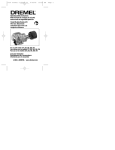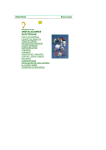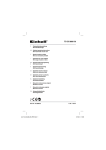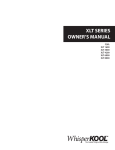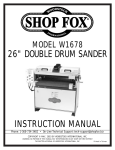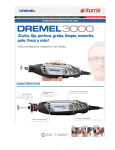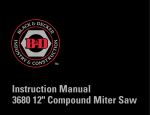Download Dremel 398 Instruction manual
Transcript
5716 Dremel 2.625x4.25 6/18/02 10:29 AM ® Operating/Safety Instructions Mode d’emploi et consignes de sécurité Instrucciones de seguridad/operación Model/Modèle/Modelo 670 Mini Saw Attachment Instrument pour mini-scie Acople de minisierra For use with models 275, 285, 395, 398, 780 Pour utiliser avec les modèles 275, 285, 395, 398, 780 Para uso con los modelos 275, 285, 395, 398, 780 Consumer Information Renseignement des consommateurs Información para el consumidor 1-800-4-DREMEL www.dremel.com Page 1 5716 Dremel 2.625x4.25 6/18/02 10:29 AM Page 2 Keep hands away from cutting area and blade. Keep your second hand on motor housing. If both hands are holding the tool, they cannot be cut by the blade. Hold the tool firmly to prevent loss of control. Figures in this manual illustrate typical hand support of the tool. NEVER place your hand behind the saw blade since kickback could cause the saw to jump backwards over your hand. If your application does not allow two-hand control of the tool, keep your hand, fingers and body positioned to either side of the saw blade, but not in line with the saw blade. KICKBACK could cause the saw to jump backwards. (See “Causes and Operator Prevention of Kickback.”) Advance the blade only in a direction where the blade teeth are coming up through the workpiece. “Climb cutting” or feeding the blade into the material so that the teeth are descending into the material, will cause the blade to climb out of the material and to jump uncontrollably in the direction of this improper feed. Be extremely careful when cutting round rods or when approaching corners or the edge of the workpiece. The blade can bind on the edge of the workpiece and cause kickback. Do not cut along a radius or curved line of cut. Kickback will occur if a curved cutting motion is attempted. Do not reach underneath the work. The guard cannot protect you from the blade below the work. Check lower guard for proper closing before each use. Never clamp or tie the lower guard into the open position. If saw is accidentally dropped, lower guard may be bent. Make sure the guard moves freely and does not touch the blade or any other part. Check the operation of the lower guard spring. If the guard and the spring are not operating properly, they must be serviced before use. Lower guard may operate sluggishly due to damaged parts, gummy deposits, or a buildup of debris. Disconnect the plug from power source. Periodically remove the blade, clean the lower guard and the hub area, or blow it clean with compressed air. Always observe that the lower guard is covering the blade before placing the tool down on bench or floor. An unprotected, 2 3 Power Tool Safety Rules Read and understand all instructions. Failure to follow all instructions listed below may result in personal injury. SAVE THESE INSTRUCTIONS ! WARNING Safety Rules for Mini Saw Attachment ! DANGER 5716 Dremel 2.625x4.25 6/18/02 10:29 AM Page 4 coasting blade will cause the saw to cut whatever is in its path. Be aware of the time it takes for the blade to stop after switch is turned off. NEVER hold piece being cut in your hands or across your leg. It is important to support the work properly to minimize body exposure, blade binding, or loss of control. Always use blades with correct size and shape arbor holes. Blades that do not match the mounting hardware of the saw will run eccentrically, causing loss of control. Do not run the tool while carrying it at your side. Lower guard may be opened by a contact with your clothing. Accidental contact with the spinning saw blade could result in serious personal injury. Know how to turn slide switch “OFF” in an emergency. If switch cannot turn “OFF” the tool quickly, unplug the tool immediately. CAUSES AND OPERATOR PREVENTION OF KICKBACK: Kickback is a sudden reaction to a pinched, bound or misaligned saw blade, causing an uncontrolled saw to lift up and out of the workpiece toward the operator. When the blade is pinched or bound tightly by the kerf closing down, the blade stalls and the motor reaction drives the unit rapidly back toward the operator. If the blade becomes twisted or misaligned in the cut, the teeth at the back edge of the blade can dig into the top surface of the wood causing the blade to climb out of the kerf and jump back toward the operator. Kickback is the result of tool misuse and/or incorrect operating procedures or conditions and can be avoided by taking proper precautions as given below: Maintain a firm grip with both hands on the tool and position your body and arm to allow you to resist KICKBACK forces. KICKBACK forces can be controlled by the operator, if proper precautions are taken. When blade is binding, or when interrupting a cut for any reason, turn off the tool and hold the tool motionless in the material until the blade comes to a complete stop. Never attempt to remove the saw from the work or pull the tool backward while the blade is in motion or 4 5 5716 Dremel 2.625x4.25 6/18/02 10:29 AM Page 6 KICKBACK may occur. Investigate and take corrective action to eliminate the cause of blade binding. Wet lumber, green lumber or pressuretreated lumber and most plastics require special attention during cutting operation to prevent KICKBACK. Avoid cutting nails. Inspect for and remove all nails from lumber before cutting. When restarting a saw in a workpiece, center the saw blade in the kerf and check that saw teeth are not engaged into the material. If saw blade is binding, it may walk up or KICKBACK from the workpiece as the tool is restarted. Support panels to minimize the risk of blade pinching and KICKBACK. Large panels tend to sag under their own weight. Supports must be placed under the panel on both sides, near the line of cut and near the edge of the panel. Do not use dull or damaged blade. Unsharpened or improperly set blades produce narrow kerf causing excessive friction, blade binding and KICKBACK. Use extra caution when making a “Pocket Cut” into existing walls or other blind areas. The protruding blade may cut objects that can cause KICKBACK. Symbols: IMPORTANT: Some of the following symbols may be used on your tool. Please study them and learn their meaning. Proper interpretation of these symbols will allow you to operate the tool better and more safely. 6 7 Symbol V A Hz W kg min s ø no .../min Name Volts Amperes Hertz Watt Kilograms Minutes Seconds Diameter No load speed Revolutions or reciprocation per/min. O Off position 1, 2, 3, ... Selector settings I, II, III, o Designation/Explanation Voltage (potential) Current Frequency (cycles per second) Power Weight Time Time Size of drill bits, grinding wheels, etc. Rotational speed, at no load Revolutions, strokes, surface speed, orbits, etc. per minute Zero speed, zero torque... Speed, torque or position settings. Higher number means greater speed Infinitely variable Speed is increasing selector with off from 0 setting Arrow Action in the direction of arrow Alternating current Type or a characteristic of current Direct current Type or a characteristic of current Warning symbol Alerts user to warning messages Ni-Cad RBRC seal Designates Ni-Cad battery recycling program Read Instruction Manual. ® C C ® ® US This symbol designates that this tool is listed by Underwriters Laboratories. This symbol designates that this tool is listed to Canadian Standards by Underwriters Laboratories. This symbol designates that this tool is listed by the Canadian Standards Association. This symbol designates that this tool is listed by Underwriters Laboratories, and listed to Canadian Standards by Underwriters Laboratories. This symbol designates that this tool complies to NOM Mexican Standards. 8 Disconnect the plug of your rotary tool from the power source before making any assembly, adjustments or changing accessories. Make sure switch is in the OFF position before plugging in. Such preventive safety measures reduce the risk of starting the tool accidentally. ! WARNING For use with Dremel Models 275, 285, 395, 398 and 780. Maximum Capacities: Blade - 1-1/4" (31.8 mm) Arbor Hole - .363" (9.22 mm) Depth at 90° - 1/4" Drive Adapter Coupling l Designates Double Insulated Construction tools Grounding terminal Functional Description and Specifications xp Designation/Explanation Type or a characteristic of current Page 8 rd E ! 10:29 AM Gu a Symbol Name Alternating or direct current Class II construction Earthing terminal 6/18/02 Sa w 5716 Dremel 2.625x4.25 Directional Guide Lower Guard Blade Washer Screw 9 5716 Dremel 2.625x4.25 6/18/02 10:29 AM Assembly Page 10 Step 2. Remove the collet. Disconnect the plug of your rotary tool from the power source before making any assembly, adjustments or changing accessories. Such preventive safety measures reduce the risk of starting the tool accidentally. ! WARNING MINI SAW ATTACHMENT INSTALLATION It is extremely important to carefully read and follow the directions below to assemble the Mini Saw Attachment to your rotary tool and ensure the tool will function properly. To properly attach the Mini Saw Attachment to the rotary tool, THREE items must be removed from the tool: the housing cap, collet nut and collet. Step 3. Unscrew the housing cap from the tool. Step 1. Press the shaft lock button, unscrew and remove the collet nut. 10 11 5716 Dremel 2.625x4.25 6/18/02 10:31 AM Note: If the collet nut and collet are not removed from the motor shaft, the tool will not function properly. Step 4. Install the drive adapter on the motor shaft and tighten. Page 12 Step 5. Screw the attachment onto your rotary tool until the coupling is tight against the housing. Hand tighten only. The attachment should be oriented on your rotary tool so that the speed control switch on the tool is easily accessible. 4 BLADE ASSEMBLY ! CAUTION To prevent damage to tool, do not over tighten drive adapter. Tighten the drive adapter finger tight and then tighten an additional 1/3 turn with the wrench. (Wrench is included with your rotary tool kit.) Disconnect the plug of your rotary tool from the power source before making any assembly, adjustments or changing accessories. Such preventive safety measures reduce the risk of starting the tool accidentally. ! WARNING Always use Dremel Saw Blades. Blades that do not match mounting hardware will run eccentrically, causing loss of control. ! WARNING 12 13 5716 Dremel 2.625x4.25 6/18/02 10:31 AM Page 14 Step 1. Mount attachment onto your rotary tool. Be sure rotary tool is unplugged and the switch is in the OFF position. Step 2. Press the shaft lock button on your rotary tool. Unscrew the screw from the mandrel and remove washer. Step 4. Press the shaft lock button on your rotary tool. Replace the washer and screw and tighten securely. Note: If washer is not used, screw will overtighten, and you will not be able to remove. Step 3. Pushing the guard foot up on the attachment, place the blade onto the mandrel arbor, making sure the arrows on the blade are facing out and the blade is resting flat on the shoulder of the mandrel arbor. Make sure the blade teeth point in the same direction as arrows on upper guard. While retracting the lower guard, check operation and condition, including the spring. 14 15 5716 Dremel 2.625x4.25 6/18/02 10:31 AM Operating Instructions TYPES OF CUTS The saw blade provided with your attachment is for both cross cuts and rip cuts. Ripping is cutting lengthwise, with the grain of the wood. Cross cutting is cutting against the grain. Your rotary tool should be running at the set speed before starting the cut, and turned off only after completing the cut. Primarily for use on wood or wood-like materials. Other materials may cause blade to wear out prematurely. Not for use on metal or masonry. DIRECTIONAL GUIDE Feed direction for the rotary tool is right to left only. Page 16 Always be sure that hands or fingers do not interfere with the free movement of the lower guard. ! WARNING Maintain a firm grip. Never force the rotary tool. Use light and continuous pressure. When cutting across the grain, the fibers of the wood have a tendency to tear and lift. Advancing the saw slowly minimizes this effect. Clean lower guard frequently to assure a rapid return of lower guard. ! WARNING This attachment is not intended for abrasive cut off wheels. Standard Dremel wheels will not fit on mandrel. ! WARNING For a straight 90° cut, use the directional guide on the left side of the guard to guide your cut. This guide also shows feed direction. Make sample cuts in scrap lumber to verify line of cut. For minimum splintering, place the good side of the material face down. Maximum depth of cut is 1/4". Not for cutting radii, curves or bevels. 16 17 5716 Dremel 2.625x4.25 6/18/02 10:31 AM CUTTING LARGE SHEETS Large sheets and long boards sag or bend, depending on support. If you attempt to cut without leveling and properly supporting the piece, the blade will tend to bind, causing KICKBACK and extra load on the rotary tool. (Fig. 1) Page 18 Figure 2 Feed Direction Figure1 Kickback Maintenance Support the panel or board close to the cut, as shown in (Fig. 2). Be sure that you cut through the sheet or board only and not the table or work bench. The two-by-fours used to raise and support the work should be positioned so that the broadest sides support the work and rest on the table or bench. Do not support the work with the narrow sides as this is an unsteady arrangement. If the sheet or board to be cut is too large for a table or work bench, use the supporting two-byfours on the floor and secure. 18 SERVICE Preventive maintenance ! WARNING performed by unauthorized personnel may result in misplacing of internal components which could cause serious hazard. We recommend that all tool service be performed by a Dremel Service Facility. TOOL LUBRICATION Your saw attachment has been properly lubricated and is ready to use. 19 5716 Dremel 2.625x4.25 6/18/02 10:31 AM CLEANING To avoid accidents always disconnect the tool from the power supply before cleaning or performing any maintenance. The Mini Saw Attachment may be cleaned most effectively with a damp cotton swab or compressed dry air. ! WARNING Always wear safety goggles when cleaning tools with compressed air. Ventilation openings and switch levers must be kept clean and free of foreign matter. Do not attempt to clean by inserting pointed objects through openings. Page 20 When cleaning gum and wood pitch from blade, unplug the rotary tool and remove the blade. Remember, blades are designed to cut, so handle carefully. Wipe the blade with kerosene or similar solvent to remove the gum and pitch. A dull or damaged blade slows the speed of cutting and places a heavier load on your rotary tool, and can cause KICKBACK. Keep extra blades on hand so you always have sharp, efficient blades ready to replace a dull or damaged one. Use only Dremel Saw Blades with your saw attachment. Certain cleaning agents and solvents damage plastic parts. Some of these are: gasoline, carbon tetrachloride, chlorinated cleaning solvents, ammonia and household detergents that contain ammonia. ! CAUTION CARE OF BLADES Blades become dull even from cutting regular lumber. If you find yourself forcing the rotary tool forward to cut instead of just guiding it through the cut, chances are the blade is dull or coated with wood pitch. 20 21











